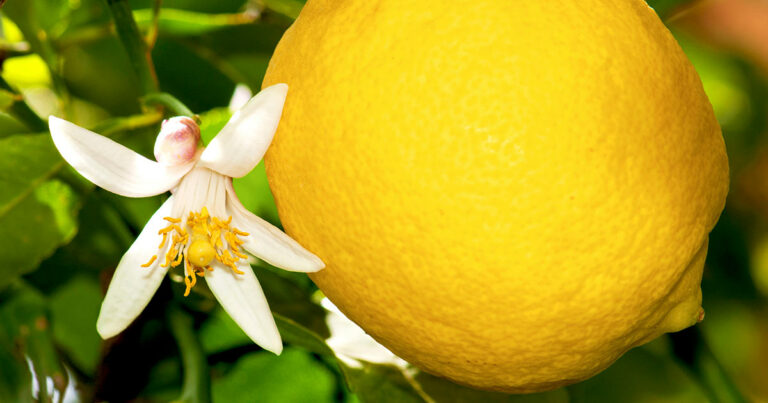Have you ever considered growing your own citrus fruit at home? If you’re not sure where to start, growing a lemon tree might just be the perfect option for you. Lemon trees, scientifically known as Citrus limon, offer a refreshing scent, beautiful color, and delicious flavor to your garden or indoor space.
Lemon trees produce mildly fragrant flowers that come from reddish buds, but we mostly love them for their oval-shaped, light-yellow fruit.
Although the true origin of lemons is unclear, they likely originated in India and were introduced to Italy in the 2nd century, then spread throughout the Mediterranean region. Lemon seeds finally arrived in the United States and became a commercial success in Florida in the 1950s.
Care
Just like Elephant Ears, Lemon trees thrive in tropical and semi-tropical climates with low to moderate rainfall, mild winters, and warm to hot dry summer heat. That’s why they grow successfully in the sub-tropical “citrus belt” of the United States, which stretches from California along the Gulf Coast to Florida.
Because they can grow up to 10 to 20 feet tall and 10 to 15 feet wide, you need to make sure to give them enough space to grow.
- Soil: For optimal growth, all citrus trees require soil with a moderate depth, medium texture, and slightly acidic pH. It’s crucial to ensure that the soil is well-drained, as citrus trees are susceptible to root rot in overly wet conditions.
- Water: Proper watering is critical, especially during their establishment period. Young trees may require frequent watering of up to once or twice a week, but mature trees develop more drought tolerance.
- Light: For optimal growth, these trees require a location that is sheltered from wind and receives full sunlight. If there’s a possibility of freezing in your area, consider planting the tree on the southwestern side of your home along a wall, which can provide additional protection.
- Temperature: They prefer warm and humid conditions with temperatures ranging between 75 to 85 degrees Fahrenheit and are highly sensitive to cold weather.
Propagation
Propagating lemon trees from cuttings is relatively straightforward. The ideal time to take semi-hardwood cuttings is from late spring to early summer when new growth has yet to bear fruit or flowers. Plant the cutting in a well-drained and consistently moist medium, ensuring warmth and humidity to maximize success.
Common Pests
Pruning
Pruning lemon trees is an important task to keep them healthy and in good shape. Once your lemon tree reaches its second year, it’s time to start pruning to avoid it becoming leggy, overcrowded, or losing its desired form.
- Timing: Prune lemon trees from their second year onward, preferably in late winter to early spring.
- Tools: Ensure you have the right tools for the job. Sharp pruners disinfected with rubbing alcohol are essential for clean cuts. For larger branches, use a clean, sharp hand-saw or pole-saw.
- Sucker Removal: Remove suckers or basal shoots at the base of the lemon tree to prevent water and nutrient theft. Cut them flush at the base as soon as you notice them.
- Dead/Damaged Branches: Throughout the year, promptly remove any dead, diseased, or damaged branches. Discolored growth or infestations should be eliminated immediately.
- Thinning: Thin out overlapping branches and the overall structure of the tree to allow sufficient aeration and light penetration. Leave at least 5 inches of mature branches to aid recovery.
- Double Shoots: Cut off the inside shoot of double shoots running almost parallel upwards.
- Crown Shaping: Remove horizontal and weak shoots that disrupt the crown’s shape. Cut them off at the base. Target selected shoots on the left side, cutting above a leaf to shape the crown attractively.
- Pruning Limit: Adhere to the one-third pruning rule, never removing more than a third of the tree in one year.
- Size Control: Keep potted lemon trees to a manageable size by ceasing to provide larger pots once they reach around four feet tall, which is optimal for fruiting in a pot.
As far as Potted Lemon Trees go: Follow the same pruning guidelines as described above. Remember to choose an appropriately sized pot to control growth.
Frequently Asked Questions
Lemon trees grow best in tropical and subtropical climates that offer mild winters and warm to hot, dry summers. They prefer well-drained soil with moderate depth, medium texture, and slightly acidic pH. They thrive in locations with shelter from wind and full sun exposure and are usually grown in the “citrus belt” of the United States, which ranges from California along the Gulf Coast to Florida.
Is A lemon a plant or a tree?
A lemon is a fruit that grows on a tree, specifically the lemon tree (Citrus limon). The lemon tree is an evergreen tree that can grow up to 10-20 feet tall and 10-15 feet wide, and it belongs to the family Rutaceae.
How long does it take for lemons to grow?
The time it takes for lemons to mature varies depending on the type of lemon tree, environmental conditions, and the level of care provided. Usually, it takes 6 to 9 months for lemons to grow and become mature after the tree has blossomed.
How long do lemon trees live?
The lifespan of a lemon tree can vary based on several factors, such as the type of lemon tree, growing conditions, and care provided. In general, lemon trees can live for several decades, with some living up to 50 years or more.
Are lemons toxic to cats?
Lemons are definitely toxic to pets such as cats or dogs. Citric acid and essential oils found in stems, leaves, seeds, and peels of citrus fruits can harm cats by irritating their nervous system. High amounts of these compounds may cause seizures, tremors, and even death for pets.
